 We visited the National Gallery of Denmark and, as with the National Gallery of Norway and the National Gallery of Sweden, what I enjoyed seeing most were the works of artists little known on the other side of the North Sea.
We visited the National Gallery of Denmark and, as with the National Gallery of Norway and the National Gallery of Sweden, what I enjoyed seeing most were the works of artists little known on the other side of the North Sea.
It was good to get away.
After the pain and worry and anguish and exhaustion of the past four months, it was good to simply cut myself off from all of that and just experience something new.
Of course, Copenhagen itself is not something new. I was there in the summer of 1974 with Henryk as part of my InterRail holiday. And Ross and I visited the city as part of our Baltic cruise in 2006.
Along with Roland, I got to see some of the other sides and parts of the city.
 We visited the National Gallery of Denmark and, as with the National Gallery of Norway and the National Gallery of Sweden, what I enjoyed seeing most were the works of artists little known on the other side of the North Sea.
We visited the National Gallery of Denmark and, as with the National Gallery of Norway and the National Gallery of Sweden, what I enjoyed seeing most were the works of artists little known on the other side of the North Sea.
 There is a strong strain of open, bleak, desolate landscapes that we tend not to get in the English landscape traditions.
There is a strong strain of open, bleak, desolate landscapes that we tend not to get in the English landscape traditions.
This depiction of Heavy Swells at the West Coast of Jutland by Niels Skovgaard is typical of the subdued palette and the geometric delineation of space.
 There is also a strong sense of an unflinching gaze into the morbid. There is no subject which is beyond the gaze of the artist providing that it is handled with sensitivity and good taste.
There is also a strong sense of an unflinching gaze into the morbid. There is no subject which is beyond the gaze of the artist providing that it is handled with sensitivity and good taste.
It's a course somewhere between the cavortings of the French and the Viennese and the hypocritical veil of the English Victorians.
I was particularly taken with Ejnar Nielsen's And in his eyes I saw death which depicts a young man shortly to die of tuberculosis.
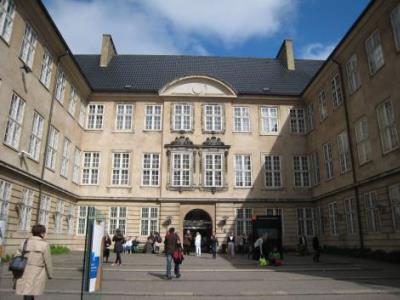 The National Museum of Denmark was also a highlight.
The National Museum of Denmark was also a highlight.
 Not surprisingly, the place had a very large area given over to Viking artefacts like the Viking axes.
Not surprisingly, the place had a very large area given over to Viking artefacts like the Viking axes.
 And these Viking shields.
And these Viking shields.
The purpose behind our visit, however, was to attend performances at Royal Danish Opera.
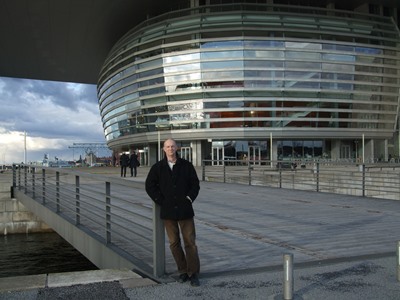 When I was here with Ross in 2006, we stood in the area of Frederik's Church (popularly known as The Marble Church or Marmorkirken for its rococo architecture) and looked across the dockland area towards the recently built Royal Opera House.
When I was here with Ross in 2006, we stood in the area of Frederik's Church (popularly known as The Marble Church or Marmorkirken for its rococo architecture) and looked across the dockland area towards the recently built Royal Opera House.
On this trip, I had the opportunity to stand outside the Opera House and look the other way towards the Marmorkirken.
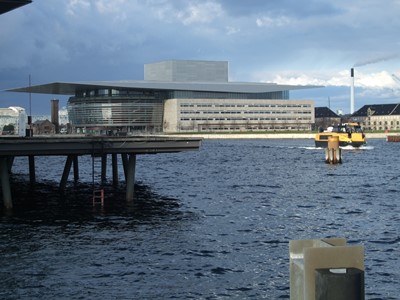
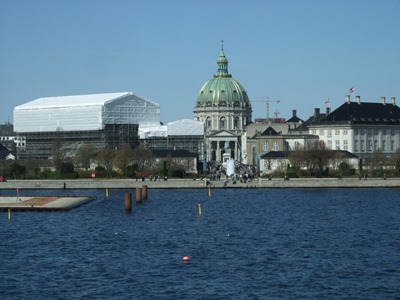
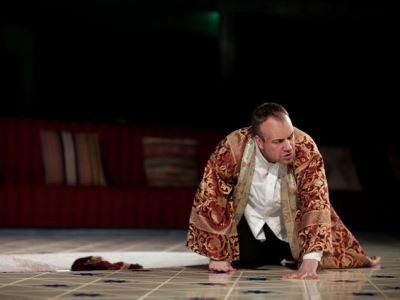 We were here to attend works by Carl Nielsen. I knew not a note of Saul og David, Nielsen's take on the biblical story also told by Handel. I'm not sure that Director David Pountney's re-setting of the drama into a contemporary Palestinian ethos gave me an easier or a more difficult entry point into what is a very densely packed score.
We were here to attend works by Carl Nielsen. I knew not a note of Saul og David, Nielsen's take on the biblical story also told by Handel. I'm not sure that Director David Pountney's re-setting of the drama into a contemporary Palestinian ethos gave me an easier or a more difficult entry point into what is a very densely packed score.
Michael Schønwandt took what was, I think, the most difficult role of the evening as conductor and allowed the music to speak even if I wasn't always capable of taking in what it was saying. Johan Reuter gave a monumental performance as the multi-faceted Saul. Niels Jørgen Riis was much softer voiced as David. I liked Susanne Resmark's Witch of Endor but wasn't convinced by her living in a small caravan.
Small caravans seem to have been a trope within contemporary stage design over the last decade.
So, I'm glad I was there to attend the performance but I'm not yet convinced about the work itself.
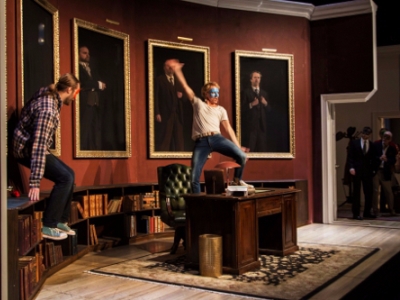 Maskarade was an entirely different matter. Kasper Holten's production was a delight from beginning to end and absolutely brimful of ideas which, to my eyes and ears, did not run counter to the spirit of the piece. I can see that more conservative audience members might baulk at the updating in the way that updatings of Mozart's Le nozze di Figaro produce a mixed reaction (I would say that it simply depends on whether or not the director is at odds with the spirit of the piece).
Maskarade was an entirely different matter. Kasper Holten's production was a delight from beginning to end and absolutely brimful of ideas which, to my eyes and ears, did not run counter to the spirit of the piece. I can see that more conservative audience members might baulk at the updating in the way that updatings of Mozart's Le nozze di Figaro produce a mixed reaction (I would say that it simply depends on whether or not the director is at odds with the spirit of the piece).
From the very first note of the overture, Per Otto Johansson led the Danish Royal Orchestra in a spirited rendition of Nielsen’s sparkling score and, by that very engagement, the audience knew that it was going to be in for a good time.
Henning von Schulman was a delightful Henrik with a powerful voice and a great talent for comic acting although he also managed to bring the right amount of gravity to the more serious parts of the role. Gert Henning-Jensen was a wonderfully ardent and youthful Leander, his bright voice ringing out in his top register. Petri Lindroos’ voice was perhaps half a size too small for Jeronimus but his Act I aria was beautifully sung and his drunken acting in Act III was utterly enjoyable.
Randi Stene slid into the role of bored housewife with apparent ease and her first act aria was a lot of fun both to watch and to listen to. As Leonora, Sophie Elkjær Jensen was lovely although her bright voice had a tendency to turn shrill at the top. Tuva Semmingsen was a seductive Pernille, clearly having a lot of fun with von Schulman’s Henrik.
A fabulous night in the theatre where the presentation totally transcended the language barrier.
 On our final morning, I spent some time wandering on my own and made a beeline for the Rundetaarn in the city centre. It was one of Christian IV's architectural projects and was built as an astronomical observatory.
On our final morning, I spent some time wandering on my own and made a beeline for the Rundetaarn in the city centre. It was one of Christian IV's architectural projects and was built as an astronomical observatory.
As a visitor, you ascend the tower using a spiral ramp with a gradual but persistent gradient. This has been used by all manner of conveyances over the centuries including motor cars, motor cycles and various types of uni, tri and bicycles. One of the most discussed exploits happened in 1716 when Czar Peter the Great ascended the staircase on horseback while his wife, Catherine I, reportedly ascended behind him in a carriage.
Fabulous. I loved every minute there.
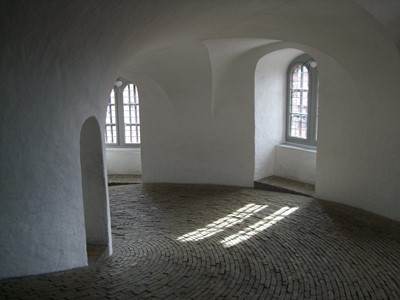
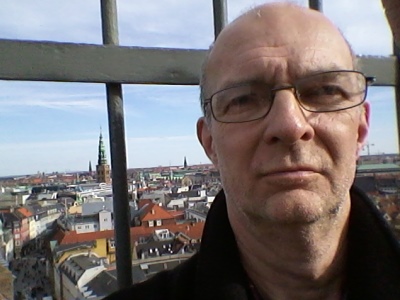
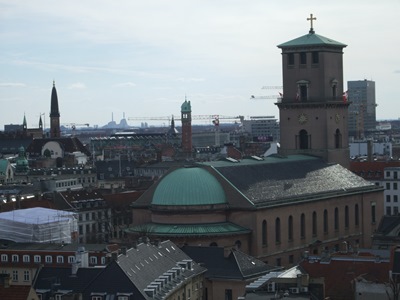
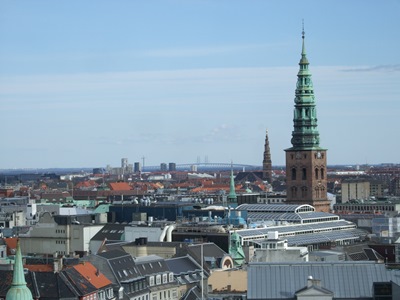
We ate well visiting places that Roland knew of old and trying out Danish delicacies like proper open sandwiches and pickled herrings done three or four different ways. We slept well. We drank a lot of Danish beer.

And almost inevitably, as I had been there on my previous two visits to the city, we ended up walking along the length of Nyhavn with its a 17th Century waterfront buildings alongside what would have been a commercial wharf. In 1974, it was all very seedy and the centre of the red light area and the shops selling pornographic magazines and super 8 films. Now, it has been extensively gentrified and made appealing to tourists.
And it was there, one night after the opera, that we encountered Csaba Szigeti, otherwise known as Kris Evans - Hungarian porn star with the Bel Ami studio. He was with a small retinue and there was an obvious frisson or fuss around his group. Roland did not know who he was but clocked him as being tall and handsome. Roland also though he was walking as though he had been fucked senseless by something very large for most of the evening until recently. I explained. We'll never know the real circumstances but it was an interesting aside.

 While we were away, I read The Miniaturist by Jessie Burton. It's set in Amsterdam during the height of the successful years of the Dutch East India Company in the Seventeenth Century. There are all manner of threads running through the narrative to do with the roles of men and women in that society, the exposure to world cultures, the trade offs between church and state and the high degree of restraint on any aberrant expressions of sexuality.
While we were away, I read The Miniaturist by Jessie Burton. It's set in Amsterdam during the height of the successful years of the Dutch East India Company in the Seventeenth Century. There are all manner of threads running through the narrative to do with the roles of men and women in that society, the exposure to world cultures, the trade offs between church and state and the high degree of restraint on any aberrant expressions of sexuality.
The book has won a number of awards but, to be honest, this was one of those occasions where I really could not understand the hype. I really could not get to grip with either the events described or the characters depicted. Big disappointment really.
Then it was home and back to work and Ross off to yet another psychiatric consultation.